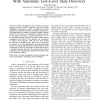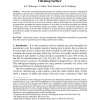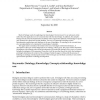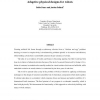567 search results - page 62 / 114 » On the complexity of constrained VC-classes |
JMM2
2007
13 years 8 months ago
2007
Abstract— Activity recognition in video streams is increasingly important for both the computer vision and artificial intelligence communities. Activity recognition has many app...
ALGORITHMICA
2000
13 years 8 months ago
2000
We describe a programmable apparatus that uses a vibrating surface for sensorless, nonprehensile manipulation, where parts are systematically positioned and oriented without sensor...
BIB
2000
13 years 8 months ago
2000
Much of biology works by applying prior knowledge (`what is known') to an unknown entity, rather than the application of a set of axioms that will elicit knowledge. In additi...
ALIFE
1998
13 years 7 months ago
1998
Creating artificial life forms through evolutionary robotics faces a “chicken and egg” problem: learning to control a complex body is dominated by problems specific to its s...
MVA
2002
13 years 7 months ago
2002
This paper proposes a novel approach to constituting all the feasible ways of folding, based on crease infomation obtained from an image of illustrations of general origami drill ...




